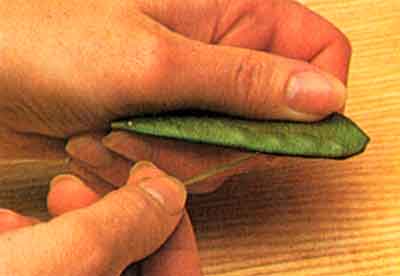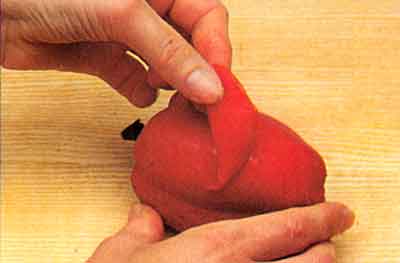Some garnishes—a sprinkling of raw parsley, for example—are mere visual embellishments; others, such as the separately cooked vegetable garnishes that surround a roast, are arranged on the platter as edible decorations.
In poultry cooking, however, garnish vegetables can be much more than merely decorative. By adding them to the bird while it cooks, you invite the flavors of the vegetables to mingle with those of the bird. Such a garnish thus becomes an integral part of the finished dish while still giving it color and contrast. Both the braising and poaching methods rely on the group of vegetables known as aromatics: carrots, turnips and onions, for example, whose robust flavors are drawn out during long cooking to enhance the bird and its sauce. In sauteing, prepared vegetables are added only a few minutes before the end of the cooking time. This gives the cook an opportunity to use delicately textured and flavored types, such as new peas or cucumbers, which would lose their shape, color and essences during longer cooking.

Stringing snow peas: Break off the stem end of each pod and pull away the fibrous strings from each edge.
For any method of cooking, most fresh vegetables need to be cleaned, peeled, shelled, trimmed or otherwise readied for the pot or pan. A few, including the six shown in the small photographs below, require some special preparation.

Cleaning leeks: Insert a knife tip at the top of the white portion and slice through the trimmed leaves. Rotate the leek a quarter turn and repeat. Rinse well.
Many garnishes used in sautes also require brief precooking. Trimmed fennel and celery are usually halved or quartered and parboiled, as are such root vegetables as turnips, carrots and potatoes. Most broad or lima beans, snow peas and shelled peas should be parboiled, but only for about a minute. Scallions and tender small beans and peas may be scattered raw on the nearly ready saute.

Seeding tomatoes: Dip a tomato into boiling water for 30 seconds, peel it, halve it, then force out the seeds and juice.
To prepare an artichoke, pull back the tough outer leaves until they break off, snap off the stem, slice off the upper tough part of the remaining leaves and, spiral-fashion, peel the outer part of the tough green base. If the artichoke is young and tender, dig down into its center with a spoon to remove the prickly choke that covers the fleshy bottom; if it is old, parboil it before removing the choke. Halve or quarter the artichoke and stew the segments in butter for 10 to 15 minutes. Then add them to the saute and cook them for a few minutes more.

Removing carrot cores. Halve old carrots lengthwise, loosen the centers with a knife, and pry out the woody cores.
Mushrooms need only be tossed quickly in butter over high heat and incorporated into the saute just before serving. Okra, too, should be cooked briefly in butter before being added to the saute. Prepare okra for cooking by cutting off the thick stem ends; do not pierce the hollow pod. Leeks and peeled boiling onions can be stewed in butter until tender. Cucumbers can be parboiled in salted water and also stewed in butter. Eggplants may be peeled or not and, like zucchini, sliced or cubed, and sprinkled with salt to draw out the bitter juices. After 30 minutes the vegetables are rinsed if salty, patted dry, then added raw or partly cooked in oil.

Peeling peppers: Broil a pepper, turning it to char the skin, which then will peel off easily. Halve it and remove the seeds and ribs.
Properly prepared, any of the vegetables shown here will complement your saute. By making your own combinations, you can invent distinctive dishes.

Removing cucumber seeds: Halve each cucumber lengthwise and scoop out the seeds with a melon baller or a spoon.

